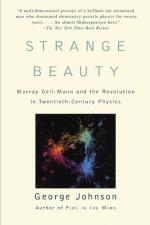|
This section contains 493 words (approx. 2 pages at 300 words per page) |

|
World of Scientific Discovery on Murray Gell-Mann
Prior to the 1940s and 1950s, only a handful of fundamental particles--the proton, neutron, electron, and positron, among them--had been discovered in particle physics research. But the study of cosmic rays and particle accelerator reactions revealed that the composition of matter was much more complex than previously thought. Dozens and then hundreds of new particles were discovered. Most appeared to meet the criterion of being a "basic" form of matter, but they often had unexpected properties. For example, some had lifetimes much longer (10-9 second) than was predicted for them, based on their mass. Because of these properties, they were collectively referred to as " strange" particles. Before long, physicists aggressively began searching for a way to organize and make sense out of the "particle zoo" they had discovered. A leading figure in this search was Murray Gell-Mann.
Gell-Mann was born in New York City on September 15, 1929. He earned...
|
This section contains 493 words (approx. 2 pages at 300 words per page) |

|


